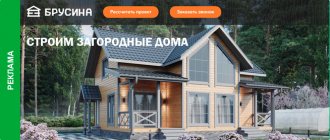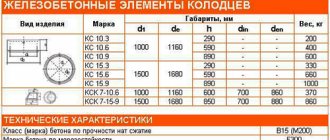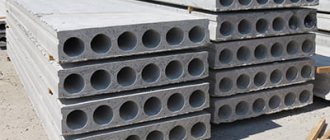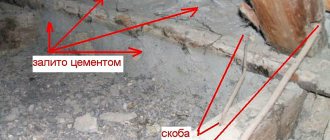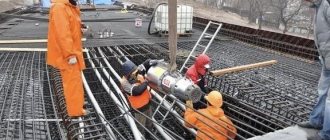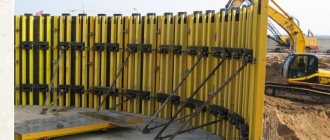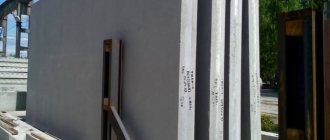Today, not a single construction project can be completed without the use of reinforced concrete products (RCP). About 2 billion concrete products are produced every day in the world, while existing technologies are constantly updated and improved.
The main advantages of using reinforced concrete structures are the speed and cost reduction of construction of houses of varying complexity. This is ensured, among other things, by the ease of manufacturing concrete products.
Characteristics of reinforced concrete structures
Main characteristics:
- Increased strength and durability.
- Ability to withstand temperature changes, including severe frosts.
- Resistant to moisture and fire.
The strength qualities of concrete directly depend on the quality of the cement and on the properties of the sand and gravel used. The final quality of concrete also depends on porosity (the ratio of the number of pores to the total volume) and density (the ratio of mass to volume).
The porosity of concrete depends on the amount of cement in the mixture and occurs due to the evaporation of excess water when there is insufficient water. The density of concrete directly affects the strength of the product and its ability to resist compression.
The resistance of reinforced concrete structures to fire is explained by their low thermal conductivity. They can tolerate, without visible damage, up to one thousand degrees of heat without consequences for a very long time. That is why concrete products are used in the construction of industrial enterprises operating at elevated temperatures.
Undoubtedly, an important feature of reinforced concrete structures is frost resistance. If the material is saturated with sufficient water, it will be able to withstand numerous temperature changes without noticeable losses in quality. According to research, the reduction in strength will be minimal.
However, despite all the advantages, concrete is characterized by very low tensile strength. To avoid the problems associated with this, reinforcement is carried out with elements made of reinforced steel (for example, wire or rods), or other materials. This product is highly durable and practically indestructible.
Conclusion
Reinforced concrete structures are used in the construction of various buildings and structures, and not only. Varieties of reinforced concrete products (panels, volumetric blocks, trusses, plumbing cabins), due to their dimensions, weights and conditions that must be observed during transportation, require narrow specialization of rolling stock.
Transportation of beams, columns, supports and racks of power lines, crossbars and piles has similar requirements for the transportation process, so the rolling stock layouts for their transportation may be the same.
Reinforcement
Reinforcement is a set of works aimed at increasing the reliability and strength of concrete products in residential and industrial construction.
Of course, one of the best examples of the use of reinforcement is to create a strong and durable base for flooring.
The main work is to create a metal base when screeding.
By using reinforcement, you can reduce the amount of concrete used. The main materials for reinforcement are:
- Reinforcing wire mesh and rods.
- Fiberglass products.
- Meshes made of polymeric materials.
Having such a wide selection of materials, at any time you can choose the best option that meets the high quality of the manufactured structure.
The main advantages of precast concrete:
- a) with prefabricated reinforced concrete, the turnover rate of the formwork sharply increases (the possibility of its repeated use) and this saves timber; with the mass factory method of manufacturing structures, steel forms are used instead of wooden ones. Accelerating the turnover of molds in factories is achieved by accelerating the hardening of concrete by steaming products or using quick-hardening cements;
- b) when using prefabricated reinforced concrete, construction time is sharply reduced due to the combination of various works in time, since prefabricated structures are manufactured in advance, and their installation using cranes is carried out quickly and practically does not depend on the time of year;
- c) the factory method of producing prefabricated reinforced concrete makes it possible to widely use mechanization and prestressing and in this way sharply reduce labor intensity and reduce metal consumption.
At the same time, prestressing makes it possible to manufacture from reinforced concrete such products as pressure water pipes (instead of steel ones, susceptible to corrosion), railway sleepers (instead of wooden ones, subject to rotting), etc.
Mass factory production of prefabricated reinforced concrete has raised the problem of unification of structures with particular urgency, as a necessary prerequisite for the profitability of such production.
Types of reinforced concrete structures
Now let's look at the types of reinforced concrete structures.
Monolithic
Monolith is the main type of reinforced concrete structures used for the construction of all types of buildings.
Reinforced concrete consists of steel and concrete mass and is called a complex building material that accelerates the pace of construction.
Advantages:
An important advantage of the monolith can be considered low material consumption. That is, spatial integrity, and, professionally speaking, high static uncertainty. Other strengths include strength, fire resistance, durability, ease of shaping, and low operating costs.
Flaws:
Due to shrinkage or force loads, there is a possibility of cracks, high heat and sound conductivity, high density. The seasonality of the work can also be considered a disadvantage, since all of it must be completed in the warm season.
Prefabricated concrete products
Precast concrete structures are finished products. FLCs are manufactured at special enterprises where the necessary devices are available. This makes it possible to reduce the cost of products and achieve high productivity.
Once upon a time, the creation of SLC had a positive effect on the increase in construction volumes. Precast concrete products are versatile and can be built in any season and in any weather.
The only downside to such prefabricated structures is their high labor intensity. Reinforcing devices are used to create joints and accordingly affect the cost.
Reinforced concrete slabs
This is a fairly widespread type of reinforced concrete products, which are used at construction sites in the construction of ceilings, walls of buildings, and partitions in both residential and commercial premises. A reinforced concrete slab is similar to a rectangle with door and window openings and protrusions for window sills. There are no openings on reinforced concrete ceiling slabs. In case of transportation, the panels are installed vertically at a slope of 10 degrees. The contact of the plates should be strictly excluded; special pads must be placed under them.
Farms
Special reinforced concrete trusses are used as floors in huge structures. They look like a flat rectangle with bars. Transportation is strictly in a standing position.
Beams and crossbars
Beams and crossbars are used as load-bearing components in the side, top and central places of a building under construction. They can be single-pitched, double-pitched or with right angles. During special transportation, the crossbars are installed straight along the entire length. To support the crossbars, they use sub-bases installed under the lower part. The distance between the spacers depends on the length of the beams. On the side they must be fixed along the entire height. Transport strictly vertically; horizontal special transportation is unacceptable; the product may be destroyed. When transporting many parts at once, dividing pads more than 10 cm thick are laid between the beams.
Piles
The construction of buildings and structures for industrial and residential purposes on soils with weak bearing capacity is impossible without the use of piles in their foundation. Concrete concrete piles are resistant to aggressive chemical attack and are little susceptible to corrosion. The piles remain operational in wet and frozen soils. Their installation is carried out using special equipment. The use of piles ensures the stability of the building, the strength and immutability of its foundation. The piles are transported by laying them horizontally and resting on wooden supports. Transportation of piles laid in several tiers is allowed.
Racks
The posts serve as supports for power lines and outdoor lighting. Their main purpose is the reliable location of electrical wires at a given safe distance from various surfaces. The use of reinforcement frame and special grades of concrete in the construction of supports ensures their reliability and long service life.
Structurally, racks are divided into types:
- end;
- intermediate;
- corner;
- anchor
In addition, racks for power transmission line supports can be single-circuit or multi-circuit.
It is allowed to group supports for their transportation, maintaining their horizontal position. It is necessary to have special pads at the points of contact.
Columns
A reinforced concrete column is a load-bearing element of the prefabricated frame of buildings and structures for industrial and housing and public purposes.
Mostly columns have a rectangular or square cross-section. For heavy crane structures, two-strand columns are produced.
Transportation of reinforced concrete columns can be carried out by stacking, when the first row is laid directly on the cargo space, and the remaining rows are laid on a flooring made of special linings.
Volume blocks
Volumetric blocks are used in the construction of buildings and structures for industry. There are separate designs used in residential and public construction. These are thin-walled elements, usually with additional filling with sound and heat insulating materials, with openings for windows and doors. They are distinguished by almost complete factory readiness.
Transportation of volumetric blocks is allowed only in a vertical position, since they do not tolerate dynamic loads that are inevitable during transportation. To prevent the block from moving during movement, special thrust projections are installed on the loading platforms.
Sanitary technical cabins (STK)
They represent a spatial structure of a sanitary unit. Cabins of this type are used in the construction of buildings for housing and public use. They have large dimensions and volumes. Transportation of the STK is permitted in a vertical position, with the support being carried out on the loading platform, using two spacers. Elevator shafts are transported in the same way. The cabins are installed on a base that is leveled horizontally.
Prefabricated monolithic concrete products
They are a collection of elements. The assembly technology is carried out by jointly laying precast concrete and monolith. In this technology, the quality of interaction between prefabricated parts and monolith parts plays an important role. Differences in shapes and dimensions of prefabricated elements are allowed to achieve the best quality. The decision is made taking into account the purpose of the objects and circumstances.
You need to know that in SMZHK the formwork for the monolith is precast reinforced concrete. Spatial rigidity is guaranteed by monolithic filling, which leads to a reduction in material consumption.
SMZHK combines the advantages of previous types. Due to their efficiency, they allow the construction of objects taking into account modern methods. Porous concrete is widely used in monolithic elements, as a result of which the weight of the entire structure is significantly reduced.
Features and Properties
The performance qualities of reinforced concrete products are determined by their multicomponent composition. Plastic reinforcement has high tensile strength, and the hardened concrete mixture resists compression. This allows elements of different shapes and sizes to be produced without the risk of cracking or deformation.
In addition, reinforced concrete products resist moisture, corrosion, fire, vibration loads, and mechanical stress. They are not affected by temperature fluctuations, aggressive environments, chemical and biological factors. Over time, they do not lose their original properties, remaining durable even after hundreds of years.
Durability, manufacturability, and great variability make them indispensable in the construction industry. Moreover, ease of installation significantly reduces the construction time of objects, opening up complete freedom for the implementation of original architectural plans.
Where are reinforced concrete products used?
They are widely in demand in the construction of public and residential buildings (administrative institutions, schools, clinics, cottages, apartment buildings), large industrial complexes (warehouses, factories, factories), as well as urban infrastructure facilities.
Precast concrete products solve many engineering and construction problems and serve for:
- strengthening basement walls;
- creating buried foundations;
- formation of interfloor ceilings;
- equipment for drainage pits, inspection wells;
- laying of drainage systems of different diameters;
- paving sidewalks, permanent/temporary roads;
- reducing loads on engineering structures, crossbars, stairs;
- arrangement of runways;
- construction of bridges;
- installation of fences.
But their functional purpose is not limited to the implementation of standard projects - concrete and reinforcement are suitable even for architectural elements of the most complex shapes.
Types of architectural concrete
There are two main types of art concrete, which differ in their scope of application.
Decorative white concrete is used for finishing facades and interior decoration. It is light and beautiful, but not designed for heavy loads.
Lightweight white concrete is used to create decorative structures: waterfalls, concrete trees, artificial rocks. You can achieve maximum similarity of its surface with natural materials - sandstone or marble. It is almost impossible to distinguish “artificial” minerals from real ones. The difference is noticeable only during operation - structures made from architectural mixtures are superior in physical properties to products made from natural materials.
Most of the decorative elements on the facade of this house are made of architectural concrete
Photo: viimiracula.ru
Each architectural concrete studio uses its own material. But the composition of mixtures from different manufacturers is similar. It necessarily includes a cement mixture and plasticizers - special substances that provide the necessary properties of the material. Another secret is paint. Finished art concrete products are coated with it on the outside.
The base is most often sand or mineral chips from granite or marble. These materials help convey the texture of natural stone. The binding component is usually cement.
The water used to create the mixture must be clean and free of impurities. Its quantity must strictly correspond to the recipe. An excess of water will turn the mixture into a cloudy liquid substance with suspensions, and a deficiency will lead to a loss of plastic properties.
The mixtures used by different studios differ in hardening time, plasticity, wear resistance, and strength.
Photo: viimiracula.ru
The works of the Seven Wonders of the World Studio use VII MIRACULA’s own composition of architectural concrete. The development of its recipe took more than 10 years. All this time, engineers sought to create a composition in such proportions that would ensure the material’s suitability for artistic surface treatment and physical strength.
The VII MIRACULA mixture fully complies with the tasks set for the artists and sculptors of the “Seven Wonders of the World Studio”
Photo: viimiracula.ru
The main properties of the architectural mixture VII MIRACULA:
- the possibility of detailed imitation of the texture of natural stone, wood, metal;
- long hardening period, providing the possibility of sculptural surface treatment;
- high strength of finished objects;
- resistance to temperature changes and exposure to sunlight - products do not fade over time;
- Possibility of use in damp areas and subject to constant contact with water.
Updated architectural mixture compositions are always tested on samples and delivered to the construction site only when we are completely confident in the result
Photo: viimiracula.ru
About the creation of reinforced concrete products
Taking into account the scope of use, each reinforced concrete product has its own reinforcement system and production technology. Concrete for each type of product is prepared according to a special recipe.
Floor slabs and other parts whose work is concentrated at the bending point are made of reinforced concrete. The latter is pre-stressed. In other words, reinforcement is placed on the stops in the mold. By a mechanical method, which involves the use of current, it is stretched and fixed at the ends of the mold.
Concrete is poured and compacted by special vibration on stands or conveyors. When the concrete is poured and compacted, the form is subjected to heat treatment in the oven. There the concrete hardens in a fairly short period of time. After this, the fastenings are removed from the metal rods. As a result, they compress, transferring their stress to the concrete mass. Those products that have the shape of a cylinder are made by centrifugation. Reinforcing bars are placed in half of the mold located on the centrifuge stand. If necessary, they are tightened. They are then wrapped with steel wire to form a frame. After this, the concrete is carefully distributed over the entire half-mold, which is then covered with exactly the same half-mold and the centrifuge is turned on. At the initial stage, the concrete mixture is simply distributed evenly throughout the form. The centrifuge then begins to spin at different speeds. As a result, the mixture is compacted on the walls of the mold and the product itself is formed. The concrete drying process also takes place in a kiln.
Artistic processing of architectural concrete products
Products made from ordinary concrete are usually dull gray in color and have primitive geometric shapes. By making objects from art concrete, you can achieve greater individuality and aesthetic appearance of the products.
Let's consider how you can make unusual decorative elements and structures using architectural concrete.
Creating cracks, weathering, wood texture
By decorating elements made of art concrete with paints and adding various additives to the mixture that improve properties, you can achieve maximum resemblance to products made from natural stones.
Using decorative painting of concrete colonnades, you can create the effect of ancient marblePhoto: viimiracula.ru
From architectural concrete you can make stones, rocks, statues, sculptures, accurately convey the texture of wood, leaves, fruits, and even create a realistic figure of a huge snake gracefully sliding from a tree.
Art concrete figures can be easily revived by decorating with paintsPhoto: viimiracula.ru
In rooms with constant humidity, where it is impossible to use metal decorative elements, they can be replaced with parts made of architectural concrete.
With the help of artificial aging of surfaces, even the most massive and large structures can look fragile and sophisticated
Photo: viimiracula.ru
Using LED lighting to create effects
LED lighting can advantageously highlight the texture of artificial stone or create the feeling that lava is flowing between the rocks.
Football store with LED illuminated display window made of artificial stone
Photo: viimiracula.ru
Creation of ornaments
You won’t surprise anyone with smooth concrete walls, but walls decorated with outlandish ornaments are another matter. After the ornament is made, it is decorated with paint - this adds texture to the image and emphasizes the bumps and lines.
Decorating the facade of a building with an ornament with Escher's birds
Photo: viimiracula.ru
About the classification of wall panels
When choosing wall panels, you must consider their classification. They are divided into classes according to the following parameters:
- According to the purpose of the building.
- According to the design solutions that will be used.
- According to the number of base layers.
Wall panels can have different structures. Therefore, they can perceive and transmit loads differently. In this case they are divided into:
- Bearers.
- Self-supporting.
- Mounted.
When choosing the type of wall panels, it is necessary to take into account not only the degree of load, but also the climatic conditions in which the finished building will be operated.
About wall panels
Wall panels are made to create external and internal walls of buildings. External elements can be single-layer or multi-layer. But single-layer ones are more popular. They are made from very light concrete, which has cells. But heavy-class concrete equipped with insulation can also be used. The outside of the panels is decorated either with a special decorative solution, or simply sealed with a concrete mixture. They are covered with paint that can withstand the vagaries of the weather or lined with special tiles. If we talk about the inner surface of the panels, then it is already prepared in advance for wallpapering or painting. If there are openings in the slab, they are often equipped with windows or doors at the manufacturing stage.
The height of the wall panels is equal to the height of one floor. Their width can reach up to seven meters. They are about thirty-five centimeters thick. Note that wall panels that are used indoors are always thinner. Their thickness usually does not exceed sixteen centimeters.
Decorative fountains
Fountain
Decorative fountains in a garden plot can serve as a dominant accent, in relation to which the perception of the entire landscape is formed. The fountain can be installed in the center of the site, the elements of which acquire a symmetrical arrangement relative to the main dominant feature. Or vice versa, a fountain can decorate a recreation area with benches.
Reservoir-bench
Concrete fountains differ in the following characteristics:
Concrete is ideal for creating a fountain, as it has the necessary water and frost resistance. Due to the plasticity of the material, the fountain can take on different shapes.Important! Since the fountain is a complex hydraulic device, its manufacture, installation and maintenance must be carried out by specialized companies.
The main requirements for fountains are: safety, durability and aesthetics.
Beautiful fountain

